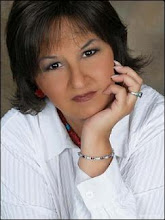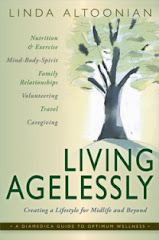Living Agelessly
by Linda Altoonian
Last week, I told you that I would be making changes over the next six months, beginning with my belief that turning 60 is the beginning of the end. Well…I’m trying mightily, but even if I completely change my attitude about 60 being old, the reality is that I look and feel older.
I don’t have the energy or stamina I once did. In fact, just thinking about what I once packed into a day makes me tired. In addition to attending school, taking care of a home and working, I modeled in my teens and twenties, chased babies in my thirties, led exercise groups in my early forties, and danced whenever someone put on music. I was constantly in motion, and I loved it. Exercise was naturally built into my every moment.
In my fifties, I sat down: in front of a computer screen to write my column and my book, at a desk to grade my student’s papers, and in chairs at various social and business functions.
To becoming more sedentary, I had added a couple of major surgeries, a problem with my knee, and thyroid disease. I had good reason for packing on pounds, but the rational did not ease the discomfort or the associated problems, and exercise, one of the solutions, had become a chore that I had to add to an already too full day. Taking a power nap became far more attractive than doing sit-ups with a power ball.
What was the resolution? Well, at least until I wanted to exercise again, I needed to find a way to consume fewer calories because I was doing less physically, and I had to burn the ones I did consume more effectively. My research suggested that an easy way to begin was with deeper breathing. Well...I knew I could do that!
In my book, Living Agelessly: Creating a Lifestyle for Midlife and Beyond, I say, "Because breathing is primarily an involuntary activity, we often take it for granted. That is a terrible mistake. Most of us use only 10% or so of our total lung capacity, which upsets the ideal balance of gases in the blood stream by preventing the removal of harmful substances.
Taking in more oxygen helps cleanse our body of a variety of waste products, including carbon dioxide. Storing toxic substances that should be eliminated from the body can diminish mental clarity, lower vitality, and increase anxiety. In addition, fast, shallow breathing can cause sleep disorders and exhaustion, stomach upset and gas, muscle cramps, chest pain, dizziness, and increased heart rate and blood pressure. Some people, who think they may have heart disease, may actually be experiencing the effects of breathing improperly.
Shallow or “chest” breathing doesn’t allow oxygen to reach the lower part of the lungs and fully saturate the blood’s capacity to hold oxygen. As a result, you breathe more rapidly, which can increase blood pressure and pulse rate. Your organs must work much harder to increase the level of oxygen in the blood. Over time, this pattern can damage your lungs and heart, diminish your energy, and increase your stress level.
Karen Van Ness developed the following exercise, to increase “lung capacity and power, to strengthen the entire torso, and to promote the unobstructed flow of internal energy that may have been blocked because of systemic stress.” She also suggests, “performing these exercises when you first wake up to get rid of the stale air and mucus that has formed through the night, and to break through the wake-up doldrums and ramp up your energy level.”
Step 1: Lie on your back with arms and legs extended and relaxed. Begin to inhale and exhale smoothly and deeply to the following count: Inhale for 4, hold for 2, Exhale for 6.
Step 2: To help make sure you are inhaling and exhaling as deeply and completely as possible, place the palm of one hand on your lower abdomen, about two inches below your navel. As you breathe, think of inhaling into this point, and exhaling from this point.
Step 3: Once you have the basic breathing pattern down, add this visualization:
With the Inhalation: Imagine clean, white, healing, purifying air entering first your lungs, then your entire body. The air is sparkling with energy. With every breath, you pull more of that energy into you.
With the Exhalation: Imagine a gray, black cloud of negative energy, toxins and impurities are being expelled from your body.
As you continue to breathe, feel and see your body becoming cleaner and more energized as you take in clean air and sparkling energy and force out impurities, toxins, and negative energy. Your body becomes filled with healing blue air—like the relaxing beautiful blue of a clear sky on a perfect day.
At this point, you should feel relaxed but energized and ready to take on the day. Mentally rehearse your goals or objectives for the day immediately after completing this exercise. See yourself achieving these goals and taking any obstacles in stride.”
I'm going to begin doing this exercise every morning before I get out of bed. I will also track its impact. Will I feel better, more refreshed and more capable of achieving the goals of the day? I'll let you know next week.


